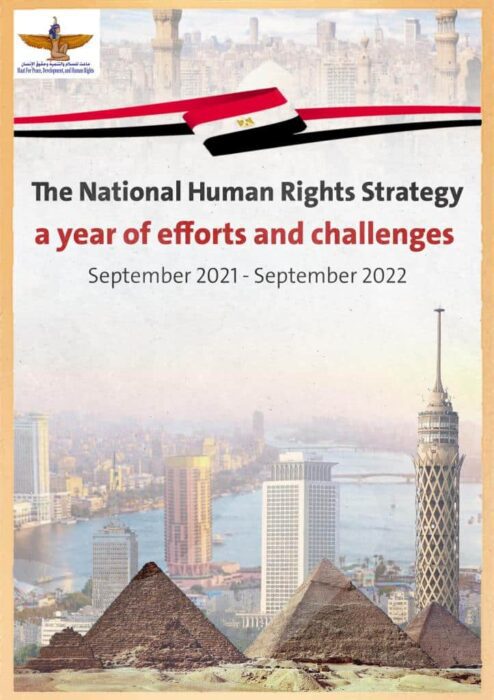One Year of Efforts and Challenges
Maat Releases a New Report to Celebrate the 1st Anniversary of the National Strategy for Human Rights
Okeil: There is a favorable opportunity now to improve and promote the human rights situation in Egypt
Sherif Abdul-Hamid: Some ministries are still reluctant to establish human rights units within their ministries
Ali Muhammad: The National Strategy for Human Rights aims to protect the rights of citizens
Today, Sunday, September 11, 2022, the Maat Foundation for Peace, Development and Human Rights issued a new report entitled “The National Human Rights Strategy: A Year of Efforts and Challenges“On the occasion of the one-year anniversary of the launch of the National Human Rights Strategy, which was announced by the President of the Republic on September 11, 2021, to make Egypt among the 39 member states of the United Nations that have approved national strategies and action plans for human rights, in an attempt to integrate the development approach that has enjoyed a great deal. Of interest in recent years, with the human rights approach that corresponds to the nature of the discourse adopted by the Egyptian state.
The three-part report - which covers i) the strategy implementation pathways; ii) the challenges facing the operationalization of the strategy; iii) the role of civil society in implementing the strategy - monitors and follows up on the progress made in the achievement of the (226) targeted objectives in the four axes that the strategy is based on, which are: the civilian and political rights; economic, social and cultural rights; rights of women, children, disabled people, youth and the elderly; and education and capacity building in the human rights field. This is done through the three operational paths upon which the strategy is based, namely; legislative development; institutional development; and education and capacity building in the human rights field.
By classifying the 226 targeted objectives on the basis of the axes making up the structure of the national strategy for human rights, the report found that executive bodies and government institutions are directly entrusted with achieving (151) objectives thereof. These bodies, in partnership with other stakeholders, work on carrying out other (42) targeted objectives. As for the legislative authority, it is entrusted with issuing or amending (33) legislative measures, in order to fulfill the strategic goals.
In order to follow up on the progress made in the implementation of the strategy, the report was based on the surveys of the relevant resolutions and measures announced on the websites of the Permanent Higher Committee for Human Rights and the entities entrusted with the implementation of the strategy, and the resolutions made in wake of the weekly meetings of the Council of Ministers since September 2021, as well as the survey of the issues of the Official Gazette.
The report indicator gave 10 points for each targeted objective achieved through legislative and institutional measures carried out by the authorities entrusted with implementing the strategy, 5 points for each objective that the relevant entities worked on but were not fulfilled, and no points for the objectives that no work has been made to achieve. According to this indicator, the entities entrusted with implementing the targeted objectives scored, in the first year, 380 out of 2260 points to be gained by September 2026. This is the end of the first phase of the timeframe set by the strategy.
The report emphasized that various positive practices have been highlighted in the first year of the strategy’s implementation, such as the near completion of the House of Representatives’ approval of four bills targeted by the strategy, namely; the Prohibition of Child Marriage Act; the Law on the Rights of the Aged; and the amendments included in the Labor Law to be approved in the 3rd session of the House of Representatives. These amendments grant women working in the private sector the same rights as their counterparts in the public sector. This, in addition to the Law on Settlement of Commercial and Civil Disputes, which, should its provisions are applied in practice, there would be alternatives to litigation and settling disputes before they reach the corridors of the courts. This covers the measures related to the legislative path.
On the other hand, the report clarified that the absence of an executive action plan is the biggest challenge facing the implementation of the strategy during the first year. Therefore, the report recommended the need to approve an executive action plan before the end of the second year of the launch of the strategy, to overcome this challenge and reach the targeted objectives of the strategy.
In this context, Ayman Okeil, an international human rights expert and President of Maat, stated that there is a favorable opportunity to improve and promote the human rights situation in Egypt, especially in light of the initiatives aimed at improving the state’s human rights file, as well as the concerted efforts of the executive, legislative and judicial authorities with national human rights bodies and civil society organizations in order to implement the axes of the national strategy for human rights on the ground to advance human rights in Egypt.
Okeil also stressed the importance of having an active civil society that helps the government implement and monitors the axes of the strategy, as it constitutes the third pillar, next to the state and the private sector, of economic and social development. Civil society is supposed to be entrusted with participating in the implementation of a number of targeted objectives of the strategy, through three main roles: follow-up and monitoring, implementation evaluation, contribution to implementation by proposing draft laws, and education and capacity building.
Okeil called for the need to complete the operational action plan of the strategy in order to achieve the objective included therein, and to clarify the roles entrusted to each entity to implement the targeted objectives of the strategy and the time frame for achieving each objective. Moreover, Okeil urged the Parliament to issue the resolutions targeted by the National Strategy for Human Rights.
For his part, Sherif Abdul-Hamid, director of the Research and Studies Unit at Maat, hailed the commendable steps taken by authorities entrusted with implementing the national strategy for human rights, which included the cancellation of the law extending the state of emergency; the Main Committee’s efforts to legalize of the status of unlicensed churches and affiliated buildings, bringing their number to 2,401 churches and buildings until April 2022; the reactivation of the Presidential Pardon Committee and releasing a large number of remand prisoners. However, on the other hand, some relevant ministries remain reluctant to establish a human rights unit within their ministries, such as the Ministry of Health, the Ministry of Trade and Industry, the Ministry of Manpower and the Ministry of Culture.
In the same context, Ali Muhammad, a researcher at Maat, indicated that the effective achievement of the human rights system, which features were laid out by the national strategy for human rights, requires ongoing follow-up and continuous self-evaluation in a way that improves the efficiency of the system and develops it, especially since the strategy came after the inauguration of a large number of institutional and legislative procedures aiming at promoting and protecting human rights, which enabled its developers to identify the key challenges facing the achievement of the targeted objectives of those policies.

 |
 |
shortlink: https://maatpeace.org/en/?p=36724












